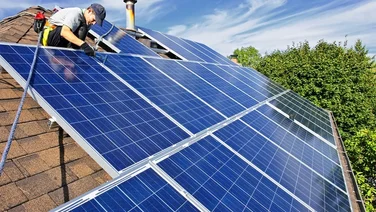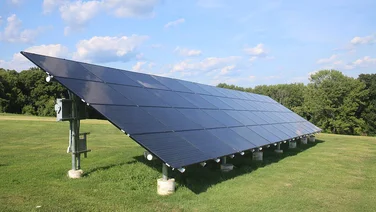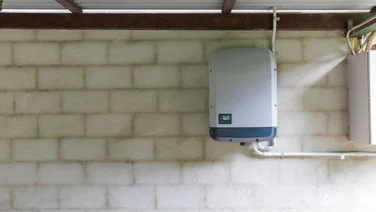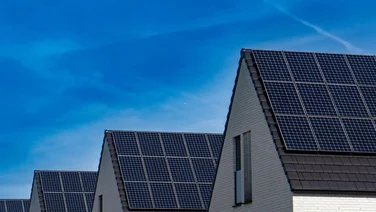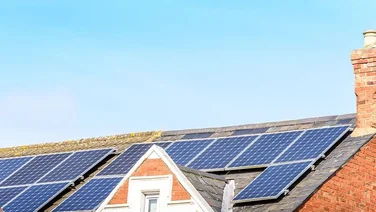✔ In an agrivoltaic farm, crops are cultivated underneath solar panels
✔ Studies show solar panels installed above plants generate 10% more electricity
✔ Leafy greens, root vegetables, and berries work well for agrivoltaic farming
Agrivoltaic farming is a space-saving way to generate solar power, which could be particularly useful in countries such as the UK, where land is limited.
Unlike traditional solar farms that occupy land exclusively for energy production, agrivoltaic systems combine agriculture and solar panels on the same plot.
If you don’t know what agrivoltaic farming is, read on. This article will take you through the basics of agrivoltaic farming, explain its advantages and disadvantages, as well as give you examples of where it’s happening in the world.

What is agrivoltaic farming?
Agrivoltaic farming is the practice of growing food crops under and around ground-mounted solar panels – in short, combining solar farms with agricultural farms.
Solar farms require a lot of space, which in some countries is in short supply. In the UK for example, over 70% of land is already farmland, which doesn’t leave much room for solar farms.
This means that solar farms are often competing for land with farmers. Agrivoltaics is a way of solving this problem, and it wouldn’t take many agrivoltaic farms to produce a lot of energy.
If around 1% of the world’s farmland were deemed suitable for agrivoltaic farming and had solar panels installed on it, this could potentially generate enough power to meet the global energy demand, according to a report from Oregon State University’s Department of Biological and Ecological Engineering.
How does agrivoltaic farming work?
In an agrivoltaic farm, solar panels are installed on poles or frames that are fixed into the ground, as they are in most solar farms. Farmers then plant crops under or around the solar panels.
Often, the solar panels are installed a few metres off the ground, or as part of a canopy, with rotating poles or frames. This leaves room for farming machinery to pass underneath and between the panels.
In an ideal agrivoltaic farm, both the crops and the solar panels benefit from this arrangement.
For the crops, the solar panels provide built-in shade so they can grow healthily. All crops require sun to grow, but too much sun can be a problem for some. The shady environment also stops some water evaporating from the soil, so less is needed in the farming process.
In turn, the plants create a cool, moist environment, which benefits the solar panels. It can get too hot for solar panels, and they operate best at temperatures under 25°C. In fact, studies at Oregon State University show that solar panels installed above plants produce 10% more electricity than those on bare ground.
How does agrivoltaic farming differ from solar farms?
In solar farms the land is only used to accommodate solar panels, and nothing else. That means no crops are grown under or around the solar panels, as is the case in an agrivoltaic farm.
There are, however, some solar farms where the land is also used for ‘solar grazing’. This is where livestock, typically sheep, are free to roam around the solar panels to eat grass.
This doesn’t technically count as agrivoltaic farming, but it’s still an efficient use of space. Having sheep graze saves the solar farm owners from needing to maintain the grass – if it gets too long, it can create a fire hazard – and the panels provide shade for sheep to rest in.
The pros and cons of agrivoltaic farming
- It’s an efficient use of limited land
- The crops are protected from the sun
- The solar panels are in a cool environment
- It reduces energy and water use
- Crop yields and solar energy production might be slightly lower
- Not all crops are suited to grow under solar panels
- Some farming machinery can’t pass under or between the solar panels
- It can be expensive to implement
Agrivoltaic farming has its pros and cons, like all things. We’ll go over them in detail in the sections below.
Advantages of agrivoltaic farming
The main advantage of agrivoltaic farming is that it makes dual use of the land, for both green energy generation and agricultural production.
Both the solar panels and the crops benefit from this arrangement. Sun-sensitive crops are protected by the solar panels, and in turn the crops create a cool environment for the solar panels to operate in.
This typically results in less energy and water use overall.
The farmers need to use less water for their crops, since the shade provided by the solar panels stops some water from evaporating in the hot sun.
Find out more about the importance of saving water and how to do it at home by reading our top tips.
Disadvantages of agrivoltaic farming
The main disadvantage of agrivoltaic farming is it can lead to slightly lower solar power generation and lower crop yields.
Basically, you can’t fit as many solar panels as you typically could in a large plot of land if you need to allow space for tractors to pass. Conversely, you can’t plant as many crops in that same plot of land if you need to make space for solar panels.
In an ideal scenario though, both the crops and the solar panels should still produce around 70% of what they would have had they not been combined, according to Martijn van der Pouw, a solar power project developer.
Another issue is not all crops are suited for agrivoltaic farming – wheat and similar grains, for example, require full sun exposure to grow well.
Lastly, some farming machinery, such as tractors or other large vehicles, can’t easily fit under or between the solar panels, making it difficult to tend to crops.
This issue can be solved by installing the solar panels on five-metre-long poles, or on frames that rotate to let tractors pass. However, these kinds of measures are expensive to implement, and not all solar farms have the funds to set this up.

What is the best type of land for agrivoltaic farming?
The best type of land for agrivoltaic farming is land that’s already being used for agriculture, or land that has strong potential for agricultural purposes.
That’s because solar farms and agricultural farms have the same needs. The ideal spot is on land that gets lots of sun, receives light winds, is exposed to moderate temperatures, and has low humidity, according to an Oregon State University report.
This type of land, if it doesn’t already have crops growing on it, usually has other plants growing, such as grasses or woods.
Where is agrivoltaic farming happening around the world?
Agrivoltaic farming is happening in a few places around the world, including in the European Union and the US. However, most agrivoltaic farms aren’t large-scale operations; they’re small research trials designed to test what forms of agrivoltaic farming work best.
One agrivoltaic farm in Colorado has successfully grown vegetables such as tomatoes, turnips, lettuce, and peppers. The farm has 3,200 solar panels, mounted 2.5 metres off the ground, which generate enough electricity to power 300 homes. It’s being used for research by several institutes, including Colorado State University.
Another agrivoltaic farm in the Netherlands has 10,250 semi-transparent solar panels installed over 3.3 hectares of raspberry crops. The project is led by BayWa r.e., a renewable energy developer that estimates the panels will be able to generate enough electricity to power 1,250 households.
BayWa r.e. plans to install more agrivoltaic farms in the Netherlands, all of which will be used for research at Wageningen University.
In France, an agrivoltaic farm is growing three hectares’ worth of soya beans under a solar panel canopy. The solar panels were installed five metres above the ground on a rotating system, and generate 3.2 gigawatt hours (GWh) of electricity a year, enough for 1,350 people.
The project is being run by TSE, an independent solar energy company, and Alliance BFC, an agricultural union. Their findings are being used for research by France’s National Institute of Research for Agriculture, Food, and Environment.
Is agrivoltaic farming happening in the UK?
To date, there’s no agrivoltaic farming happening in the UK, and no plans have been made to launch any trials.
The closest thing to agrivoltaic farming in the UK is a solar beekeeping project funded by Low Carbon, a British investment and asset management company. Low Carbon has set up beehives to produce honey in select solar farms across the UK that have wildflowers growing on them.
Additionally, transparent solar panels have been attached to greenhouses growing berries in Kent, as part of a government-funded study by the University of Greenwich.
Summary
The success of small-scale agrivoltaic farms could pave the way for larger agrivoltaic projects.
Whilst the UK government has not yet announced any plans to implement agrivoltaic farming, it needs to start generating more renewable energy if it wants to meet its 2050 deadline for reaching net zero emissions.
Solar power is one way to do this, and agrivoltaic farming could solve the UK’s problem regarding its lack of free space. It could also help quell some farmers’ fears that the expansion of solar power is a threat to farmland.
Agrivoltaic farming: FAQs
What crops work best with agrivoltaic farming?
As a general rule the crops that work best for agrivoltaic farming are shade-resistant ones (meaning they grow well in the shade), such as leafy greens, root vegetables, berries, tomatoes, and peppers.
However, what crops will work best in a specific agrivoltaic farm very much depends on the climate they’re planted in.
For example, in particularly sunny hot places, such as southern Europe, less shade-resistant crops – such as olive trees or grape vines – might also be good candidates for agrivoltaics.
Where is the biggest solar farm in the UK?
The biggest solar farm in the UK is Shotwick Solar Park in Flintshire, Wales. It has a peak capacity of 72.2 megawatts, and generates enough electricity to meet 60% of the energy needs of a nearby paper manufacturing plant.
Can you put solar farms on agricultural land in the UK?
Yes, you are legally allowed to install solar farms on agricultural land in the UK, as long as the land isn’t designated as a protected or listed site, or part of a conservation area.
All solar farms require planning permission in the UK, and if they have a capacity of more than 50 megawatts, they require development consent from the Secretary of State for the Department of Energy Security and Net Zero.
Additionally, if you do not own the land you want to set up a solar farm on, you must have permission from the owner before starting installation.

